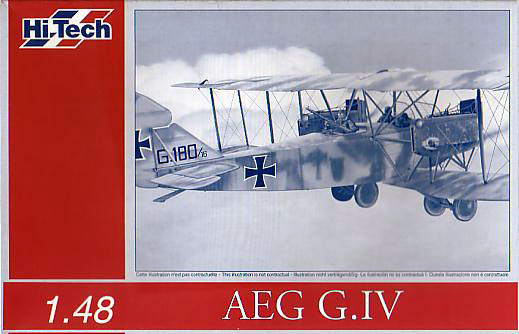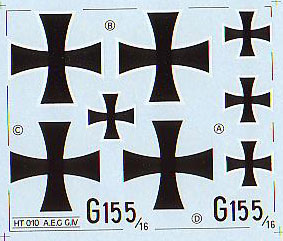|
AEG G.IV

Hi-Tech

Hi-Tech's 1/48
scale AEG G.IV is available online from Squadron.com
S
u m m a r y
|
| Catalogue Number: |
Kit No. HI0010 |
| Scale: |
1/48 |
| Contents and Media: |
46 injection molded plastic; 18
resin, 12 white metal & 1 fret of photo-etched detail parts. |
| Price: |
USD$49.96 from
Squadron.com |
| Review Type: |
FirstLook |
| Advantages: |
Accurate mouldings; good use of
multi-media |
| Disadvantages: |
PE loose in box; vague instructions;
warped wings (although easy to fix) |
| Recommendation: |
Recommended for experienced builders
of WWI Aircraft. |
Reviewed by Robert Baumgartner
When first announced, most WW1 modellers couldn’t believe what they
were hearing. Now finally it is here, the long awaited AEG G.IV from
Hi-Tech.
Contents
As pointed out in Hi-Tech's instructions, this is a “Short-Run” kit. The
plastic parts are more reminiscent of Eduard’s first releases, but this is
not such a bad thing. All pieces are fully moulded with the usual stray
flash to be cleaned up. Gone are the frosty surfaces that marred the
plastic of previous releases and this time the parts actually do
fit in the supplied box.
Click the thumbnails below
to view larger images:
The instruction sheets give an exploded diagram showing where most of
the pieces fit, but the rigging diagram is limited to what can be gleaned
from the 3 view drawing and box top art. A welcome idea is the use of
close up photos of the real aircraft appearing on these sheets but
unfortunately their clarity has suffered in the reproduction process.
Other sources of reference material would be a great help to the builder
here and Hi-Tech give such a list. It is pleasing to see a manufacturer
having the courage to list the documentation it has used in the making of
the kit.
Although the resin and white metal items are contained in their own
plastic bag, the delicate photo-etched fret had no such protection and was
left to fight for space with the plastic sprues in the bottom of the box.
This inevitably led to damage being done to the fret. The plastic parts
are contained on four sprues, with two copies being supplied of the one
containing the engine nacelles, struts, tailplane and elevators.
Accuracy
When compared against Ian Stair’s plans in Windsock Datafile 51, it is
clear that Hi-Tech has used this publication as their primary reference.
The outlines of the parts match almost perfectly.
Wings
The wings on my example were slightly bowed but it was easy enough to
straighten these out by using hot water while gently bending the parts in
the opposite direction to the bow. It only took twenty minutes to rectify
all four affected parts. Be careful to leave in some washout at the
aileron and lower wingtips though!
The only other issue with the flying surfaces is that the rib tapes,
although complete, are a bit prominent so a light sanding would not go
amiss here. Considering that this is a short-run kit, the wing trailing
edges are commendably thin.
As per the original machine, the top wing is in three parts and each lower
wing is spit in two, so some careful pinning is called for. When joining,
note that contemporary photos show the top outer wing panels tend to be
slightly higher at the trailing edge than the centre panel.
Other Material
Resin and white metal are used for the items that need more detail than
Hi-Tech’s plastic injection techniques will allow. Things like engines,
wheels, radiators (these are beautiful), exhausts, machine guns,
instrument panel, seat, and both wing and fuselage tanks are made in
resin. The white metal parts are restricted to the Wolff propellers,
gunner’s seats, tailskid, magazines and engine add-ons.
Click the thumbnails below
to view larger images:
A kit like this needs photo etched parts and Hi-Tech provide these in
the form of 28 different items totalling 67 parts. This fret is actually
supplied by Eduard and includes the propeller guards, bomb racks, prop
bosses, machine gun mounts, seat belts, and other various cockpit items.
Markings
 Decals
are for one aircraft, AEG G.IV 155/16. This machine has been photographed
with both the pre-production and production rudders. Hi-Tech provide the
latter. The colours given in the instructions are rather unclear, this
being the result of confusion as to how the real aircraft was camouflaged. Decals
are for one aircraft, AEG G.IV 155/16. This machine has been photographed
with both the pre-production and production rudders. Hi-Tech provide the
latter. The colours given in the instructions are rather unclear, this
being the result of confusion as to how the real aircraft was camouflaged.
Nearly all aircraft in the G.153-G192/16 series were sprayed in a mottle
pattern and here is where the controversy starts. There are two views
here:
-
The base colour is a light blue with a darker
blue mottled over the top.
- The base colour is a light blue with a possible mottle of dark green
and red/brown (as photos appear to show a total of three tonal values).
The choice is yours.
The very nature of this aircraft means that a model of this subject
will always be a challenge to build. Hi-Tech have helped us on the way
with a package that provides the builder with a good foundation to start
from.
The only real downside is that the packaging allows damage to the photo
etched fret and the instructions can be a bit vague.
Hi-Tech should be applauded for their ambitious chose of subject and
hopefully we can look forward to other multi-engine WW1 aircraft.
Thanks to
Squadron.com for the review
sample.
Review and Images Copyright © 2002 by
Robert Baumgartner
Page Created 15 March, 2002
Last updated 22 July, 2003
Back to HyperScale Main Page
Back to Reviews Page
|
Home | What's
New | Features
| Gallery |
Reviews | Reference
| Forum
| Search